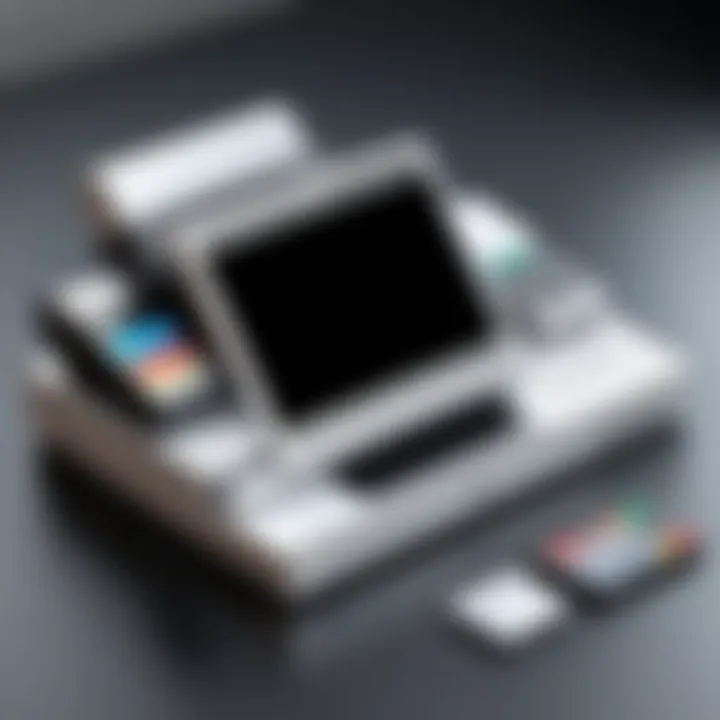Exploring POS Systems: Functions and Best Practices


Intro
In today's fast-moving business world, the use of effective technology is critical for success. Ordering POS systems are at the forefront. They streamline transaction processes, enhance customer experience, and integrate essential functions like inventory management and reporting. This guide will delve into the various aspects of these systems, equipping decision-makers and business leaders with valuable insights to make informed choices.
Software Category Overview
Definition and Importance
Ordering POS systems refer to electronic point-of-sale systems specifically designed for processing orders in retail and service environments. They replace traditional cash registers, offering greater efficiency and accuracy. Their relevance has grown amid the increasing demand for instant service and seamless transactions.
Businesses that utilize these systems can effectively manage sales, control inventory, and analyze customer data. The rise of online and mobile ordering has further propelled their importance, making it essential for businesses to keep pace with technological advancements.
Key Characteristics
Several characteristics define high-quality ordering POS systems:
- User interface: Intuitive design is vital for ease of use.
- Integration capabilities: Compatibility with existing software solutions or hardware enhances functionality.
- Reporting and analytics: The ability to generate insights about sales and inventory can guide strategic decisions.
- Security features: Strong security protocols protect sensitive financial and personal data, nurturing customer trust.
Comparative Analysis of Top Software Options
Feature Comparison
When assessing different ordering POS systems, features vary significantly. Consider the following features in comparison:
- Order management: Look for systems that handle different order types, including in-person, takeout, and delivery.
- Payment processing: Modern systems support multiple payment methods, from credit cards to digital wallets.
- Loyalty programs: Systems with integrated loyalty programs can enhance customer retention.
Pricing Models
Understanding the pricing structures of these systems is crucial. Many options exist:
- Subscription-based: Monthly fees for access, typically including updates and support.
- One-time purchase: Payment for software is made upfront, often with future costs for maintenance.
- Commission-based: Some systems charge a fee per transaction, which may suit smaller businesses.
Selecting the right model depends on business size, expected transaction volume, and budget.
"Choosing an ordering POS system requires careful consideration of operational needs and long-term goals."
The article proceeds to explore additional sections on best practices and the future of ordering POS systems. It aims to provide a comprehensive understanding of the profound impact these systems can have on enhancing business operations.
Preface to Ordering POS Systems
Ordering POS systems play a pivotal role in the modern business landscape. As the interface between a customer’s intent to purchase and the retailer’s ability to deliver, these systems streamline transactions and enhance operational efficiency. Understanding ordering POS systems is crucial for businesses aiming to optimize their processes and improve customer satisfaction. In this piece, we will explore the intricacies of these systems, laying the groundwork for informed decision-making and strategic implementation.
Definition of POS Systems
POS stands for Point of Sale. A POS system is not just a cash register but a comprehensive platform that facilitates the exchange between the customer and the business. It includes hardware components, such as touchscreen monitors and barcode scanners, along with software that manages sales, inventory, and reporting. This integration enables businesses to process payments swiftly and manage transactions effectively.
By utilizing a POS system, businesses can gather data about customer purchases, track inventory levels, and analyze sales trends. This insight is invaluable for both inventory management and marketing strategies, making the definition of POS systems foundational to understanding their ordering capabilities.
Overview of Ordering Capabilities
Ordering capabilities within POS systems encompass various functionalities that enhance the purchasing process. These capabilities often include:
- Order Management: The system allows businesses to take, process, and fulfill orders seamlessly. This management reduces the chances of errors and optimizes the order flow, giving staff more time to focus on enhancing customer service.
- Customer Relationship Management: Integrated CRM features help businesses maintain loyal customer relationships. Businesses can collect and analyze customer data to tailor promotions and service offerings.
- Mobile Ordering Options: With the rise of mobile technology, many POS systems now support mobile ordering features. This allows customers to place orders through their smartphones or tablets, further simplifying the purchasing experience.
A clear understanding of these ordering capabilities is essential. They not only improve operational efficiency but also create a more satisfying experience for the customer. As businesses move further into the realm of digital, exploring these systems becomes increasingly relevant.
Key Features of Ordering POS Systems
The key features of ordering POS systems provide the foundation for their effectiveness in managing business transactions. Having the right functionalities allows businesses to operate smoothly while enhancing customer satisfaction. Each feature serves a specific purpose and collectively shapes overall operational efficiency. Understanding these features is essential for decision-makers who want to invest wisely in technology that aligns with their business needs.
User-Friendly Interface
A user-friendly interface is critical for any ordering POS system. If the system is difficult to navigate, employees may struggle to carry out their tasks efficiently. This can lead to longer wait times for customers and potential loss of sales. A straightforward design helps reduce the learning curve for new users.
Moreover, intuitive layouts facilitate quicker transactions. When staff can easily locate menu items or process payments, it improves the overall customer experience. This is particularly important in fast-paced environments like restaurants or retail settings.
In summary, a user-friendly interface minimizes errors and accelerates service delivery, which is crucial for maintaining customer loyalty.
Inventory Management Integration
Inventory management integration is another vital feature of modern ordering POS systems. This functionality allows businesses to track stock levels in real-time. Accurate inventory management enables timely reordering of products, avoiding stockouts that could frustrate customers. This integration contributes directly to an organization’s operational efficiency and bottom line.
When POS systems are connected to inventory databases, businesses can analyze sales trends. Identifying which products are consistently selling well allows for better purchasing decisions. In addition, this visibility aids in reducing waste, particularly in industries like food service where perishables are prominent. Having an integrated system not only streamlines operations but also can result in significant cost savings over time.
Analytics and Reporting Capabilities


Analytics and reporting capabilities within an ordering POS system empower decision-makers with valuable insights. By generating detailed reports on sales patterns, customer preferences, and employee performance, businesses gain a comprehensive understanding of their operations.
These insights are instrumental for strategic planning. For example, identifying peak hours can help in staffing planning. Additionally, data-driven decisions can improve marketing strategies by understanding customer behaviors and preferences.
Effective reporting translates raw data into knowledge that informs decisions and drives profit margins.
Regularly analyzing this data can highlight areas needing improvement and uncover opportunities for growth. In this way, analytics within a POS system can significantly enhance long-term success.
Benefits of Implementing Ordering POS Systems
Implementing an ordering POS system can offer numerous advantages to businesses. Understanding these benefits is essential for decision-makers seeking to improve operational efficiency and enhance customer satisfaction. The evolution of technology in point-of-sale systems has made them integral to modern business operations. Organizations that adopt these systems may find themselves more competitive due to increased accuracy and efficiency.
Improved Order Accuracy
Order accuracy is a critical factor in the success of any business. Inaccurate orders can lead to customer dissatisfaction and loss of revenue. With a robust ordering POS system, businesses can minimize human errors associated with manual order taking or processing. The system automates many processes, ensuring that the details captured at the point of sale are correct.
For example, ordering POS systems often use machine learning algorithms to predict items that are frequently ordered or identify patterns in customer behavior. This predictive capability allows businesses to tailor their offerings, reducing the likelihood of mistakes.
Advantages of improved order accuracy include:
- Reduction in item returns due to order inaccuracies.
- Increased accountability in the order management process.
- Enhanced trust from customers experiencing fewer errors.
Moreover, better order accuracy directly correlates to higher customer retention rates. Satisfied customers are more likely to return, and their positive experiences may lead to word-of-mouth referrals.
Streamlined Operations
The implementation of an ordering POS system streamlines operations significantly. Businesses can automate various processes, leading to improved efficiency in workflow. For instance, manual inventory counts can be replaced with real-time inventory tracking, allowing organizations to manage stock levels more effectively.
Automated systems can also improve communication between different departments, such as sales, inventory, and customer service. These systems provide instant access to information across these areas, reducing delays.
Key elements of streamlined operations include:
- Efficient order processing that reduces wait times.
- Centralized data management that improves decision-making.
- Real-time updates that help staff manage customer inquiries quickly.
Moreover, streamlined operations can reduce operational costs. By minimizing waste and optimizing resources, businesses can redirect funds into growth initiatives.
Enhanced Customer Experience
A well-implemented ordering POS system can create a more robust customer experience. Consumers today expect fast and reliable service. They appreciate when businesses use technology that makes transactions quick and easy. Ordering systems allow for reduced wait times and personalized experiences based on previous purchases.
Features such as customer loyalty programs integrated into the POS solutions allow for tailored promotions, which can enhance customer engagement. For example, if a customer frequently orders the same item, the system can suggest similar products or offer discounts based on past purchases.
Benefits of enhanced customer experience may include:
- Increased customer loyalty due to personalized recommendations.
- Higher satisfaction rates as customers enjoy quick service.
- More effective handling of customer feedback and queries.
Challenges in Adopting Ordering POS Systems
Adopting an ordering POS system comes with its own set of challenges that businesses must navigate carefully. Understanding these challenges is integral not only for successful implementation but also for ensuring long-term benefits. Key factors like costs, training requirements, and technical maintenance can significantly affect the processes surrounding the deployment of these systems. Acknowledging and addressing these challenges can lead to better decision-making and more effective use of resources.
Cost Considerations
The financial impact of implementing an ordering POS system is one of the major challenges faced by businesses. The initial purchase price of the system can be steep, especially for small and medium enterprises. Additionally, businesses must consider the costs of necessary hardware, such as terminals and printers. These costs can pile up quickly.
Beyond the initial outlay, ongoing expenses often include software licensing fees, maintenance plans, and possibly even transaction fees. Organizations need to perform a comprehensive cost-benefit analysis to evaluate the return on investment.
Factors to consider include:
- Setup Costs: Installation charges and any necessary infrastructure upgrades.
- Monthly Subscription Fees: For cloud-based POS systems.
- Hidden Fees: These can include transaction costs, tech support, and software updates.
- Long-term Scalability Costs: As businesses grow, additional licenses or features may be needed, increasing costs further.
Balancing these costs with the expected efficiency improvements and enhanced customer experience is crucial.
Training Needs for Staff
Training employees to effectively use a new ordering POS system is another challenge that cannot be underestimated. This training is vital for maximizing the system's potential and ensuring a smooth transition. Without adequate training, users may struggle and cause disruptions in service.
Deciding the mode of training can also present challenges:
- In-house Training: Employing existing staff to train new users may be cost-effective; however, it can strain resources.
- External Training: Bringing in specialists or using comprehensive training programs can ensure effective learning but can increase costs substantially.
- Ongoing Training: As software updates occur, continued education for staff will be necessary, requiring a system for refresher courses.
Training should not just focus on how to operate the system but also on troubleshooting common problems. This holistic approach minimizes errors and improves user confidence, leading to more effective system usage.
Technical Support and Maintenance
Once the ordering POS system is in place, businesses must ensure proper technical support and maintenance. An efficient support system is crucial for resolving any operational issues. The quality of technical assistance can vary widely between providers, making vendor reputation a key consideration.
Effective support includes:


- 24/7 Availability: This is important for businesses that operate during unconventional hours.
- Response Time: Quick response times can minimize downtime significantly.
- Capability for Remote Assistance: This allows issues to be addressed without needing on-site visits, saving both time and costs.
Maintenance is another factor, involving regular updates and system checks to ensure everything operates smoothly. Companies need to budget for this ongoing maintenance effectively to avoid unexpected costs down the line.
By acknowledging these challenges and actively planning for them, organizations can position themselves for a more seamless integration of ordering POS systems in their operations.
Selecting the Right Ordering POS System
Choosing the appropriate ordering POS system is crucial for any business aiming to enhance operational efficiency and customer satisfaction. A well-selected system not only streamlines the ordering process but also integrates seamlessly with other business functionalities. Misalignment between a business's requirements and the capabilities of a POS system can derail efforts to improve service quality and operational effectiveness.
Assessing Business Requirements
To begin with, it is essential to assess the unique needs of the business. This involves a close examination of existing workflows, customer interaction methods, and specific pain points that need addressing. Questions to consider include:
- What are the most common types of transactions?
- How many employees will be using the system?
- What features are deemed essential?
Consultation with staff who will directly interact with the system can provide valuable insights. Furthermore, understanding the customer base can aid in tailoring the features offered. A restaurant, for example, may prioritize quick table service processing, while a retail operation might emphasize inventory management functionalities.
Evaluating Software Options
Once business requirements have been clearly outlined, the next step involves evaluating software options. The market is not short of solutions, with platforms like Square, Toast, and Shopify providing distinct offerings. It is important to consider not just the functionality of each system, but also how well they integrate into existing operations. Some critical factors to review include:
- User Experience: Is the interface intuitive for both employees and customers?
- Customization: Can the software adapt to specific business needs?
- Scalability: Will the system still be effective as the business grows?
Researching user reviews and comparing features can help in making an informed decision. Participating in demos allows potential users to experience the software firsthand, providing a clearer picture of its usability.
Vendor Reputation and Support
Finally, the reputation of the vendor and the support they provide is an important consideration. A well-established vendor usually offers more reliable service and support. Factors to keep in mind include:
- Customer Support Availability: Is support readily accessible?
- Training Resources: Does the vendor offer comprehensive training materials?
- Reviews and Case Studies: What do existing customers say about their experience?
Researching these aspects will aid in determining if a particular vendor is a good fit. Moreover, having strong support channels can greatly reduce downtime during implementation and ongoing operation.
"Selecting a POS system is not just about the price. It’s about the value it brings to the business and how it aligns with strategic goals."
In summary, selecting the right ordering POS system requires a careful assessment of business needs, evaluation of software options, and diligence in reviewing vendor reputation. Each of these elements contributes significantly to the overall success of the integration process.
Implementation Strategies for Ordering POS Systems
Implementing an ordering Point of Sale (POS) system demands careful strategizing. Proper implementation can significantly affect operational efficiency and customer satisfaction. The success of these systems relies not only on the technology itself but on the meticulous planning and execution of the deployment process. This section explores key strategies that businesses should consider during implementation.
Planning the Rollout
Planning is the first and crucial step in the implementation of an ordering POS system. This process involves several key components:
- Assessing Current Infrastructure: Before introducing new technology, it is vital to assess existing systems. This helps in understanding compatibility and helps sketch an integration plan.
- Defining Objectives: Setting clear goals for what the new system should achieve can drive focused deployment. Whether it involves increasing the order accuracy, reducing wait times, or improving customer service, having targeted objectives ensures a more effective rollout.
- Establishing a Timeline: A detailed timeline allows for organized scheduling and coordination of different phases of the implementation process.
- Engaging Stakeholders: Involving employees, management, and key stakeholders at this stage assures buy-in and smoothens the process. Each party's input can highlight unique considerations and facilitate a more tailored implementation.
"A well-planned rollout enables companies to minimize disruptions and maximize the potential benefits of a new POS system."
Executing Training Programs
Training is paramount for successfully transitioning to a new ordering POS system. A comprehensive training program should include:
- Hands-On Training: Employees should have the opportunity to familiarize themselves with the system through practical experience. Simulations can prepare them for real-life scenarios they might face once the system is live.
- Ongoing Support: Establishing a support system facilitates additional help for those who may struggle. Continuous access to resources is essential for building confidence and competence among the staff.
- Feedback Mechanisms: Creating channels for employees to provide feedback on the system enhances usability. It allows for ongoing refinement and adjustment of training materials and strategies based on user experiences.
Measuring Performance Post-Implementation
Once the system is up and running, measuring its performance becomes crucial. This assessment can indicate areas of improvement and successes. Key performance indicators (KPIs) might include:
- Order Accuracy Rates: Track how often orders are fulfilled correctly compared to past metrics to assess if the new system is meeting its objectives.
- Customer Feedback: Gathering customer insights through surveys or feedback forms helps gauge satisfaction levels with the new system.
- Sales Data Analysis: Evaluating sales trends pre- and post-implementation highlights the impact on revenue.
Regular reviews and evaluations not only confirm that goals are being met but also pave the way for future enhancements in the ordering process. Through these meticulous strategies, businesses can optimize their use of ordering POS systems for lasting success.
Market Trends in Ordering POS Systems
In the dynamic landscape of business technology, staying informed about market trends in ordering POS systems is crucial for organizations seeking to enhance efficiency and customer satisfaction. The integration of these systems has evolved significantly, influenced by a variety of factors including technology advances and changing consumer preferences. Understanding these trends helps businesses make sound decisions that align with current and future operational needs.
Emerging Technologies in POS Systems
Emerging technologies are reshaping how ordering POS systems function today. Advancements in artificial intelligence and machine learning provide significant opportunities for these systems to analyze customer behavior and streamline operations. For example, AI-driven analytics can predict demand patterns, allowing businesses to optimize inventory levels and enhance service speed.
Moreover, the incorporation of mobile payment solutions is also notable. Consumers increasingly prefer quick, contactless payment methods over traditional cash or card transactions. This trend forces businesses to adapt swiftly, ensuring their POS systems can accommodate various payment options.
Additionally, cloud computing technologies enable real-time data access from multiple locations. Businesses with multiple outlets can maintain centralized control over transactions, leading to improved data accuracy and reporting capabilities.


Shifts in Consumer Behavior
Consumer behavior is ever-changing, and this can greatly impact how businesses utilize POS systems. The rise of online shopping and digital engagement has shifted many customer expectations. Customers now demand a seamless omnichannel experience. They often check products online before visiting a store or expect to complete orders quickly through mobile apps.
To respond to these shifts, ordering POS systems must offer integrated solutions that connect in-store and online sales. Features like real-time inventory updates and click-and-collect options can directly enhance customer satisfaction. Businesses that effectively adapt their POS capabilities to match consumer preferences will likely retain and attract customers in a competitive marketplace.
Regulatory Influences on POS Solutions
Compliance with regulations can profoundly influence the development and functionality of ordering POS systems. Several factors must be considered:
- Data Protection Regulations: With the rising focus on data security, compliance with laws such as GDPR has become a necessity. Businesses must ensure that their POS systems are equipped to handle sensitive customer information securely.
- Payment Processing Standards: Adherence to PCI-DSS standards is essential for any system handling card transactions. Failure to comply can result in serious penalties and loss of customer trust.
- Tax Regulations: Particularly for businesses operating across regions, having a POS system that can adapt to varying tax laws is critical. This ensures accurate tax calculations and reporting, ultimately reducing the risk of audits and associated penalties.
Effective POS solutions are being developed with these regulatory concerns in mind, and organizations must choose systems that meet these evolving requirements.
"Understanding market trends is not just about keeping pace; it’s about gaining a competitive advantage in a rapidly evolving marketplace."
By considering emerging technologies, consumer behavior shifts, and regulatory influences, businesses can ensure their ordering POS systems are not only current but also future-ready.
Case Studies of Successful POS Implementations
Analyzing case studies of successful Point of Sale (POS) implementations offers valuable insights for businesses considering the transition to ordering POS systems. These real-world examples illustrate the practical benefits of incorporating technology into established workflows and showcase the transformative potential of these systems. By examining diverse scenarios, decision-makers can visualize the advantages and challenges associated with deploying these solutions in their own environments. Notably, case studies provide concrete evidence for the effectiveness of specific features and strategies that can influence the overall performance of a business.
Retail Sector Examples
In the retail sector, numerous companies have adopted ordering POS systems to streamline their operations. A notable example is Target, a leading retail corporation known for its wide range of products. Target implemented a comprehensive POS solution that integrates inventory management, sales tracking, and customer engagement functionalities. This system allows Target to maintain real-time inventory visibility, which helps in minimizing stockouts and ensuring that popular items are readily available.
The case of Target highlights significant benefits such as improved order accuracy and faster transaction processing. By using a robust POS system, employees can swiftly process transactions, leading to shorter wait times for customers. This not only enhances customer satisfaction but also increases overall sales volume.
Another example is Walmart, which has continually innovated its POS technology. By integrating mobile POS solutions, Walmart enables employees to complete transactions anywhere within the store. This mobility permits a more personalized shopping experience and reduces congestion at traditional checkout lines. The results have reflected in higher customer throughput and operational efficiency, showcasing the effective application of ordering POS systems in a retail context.
Hospitality Sector Examples
In the hospitality industry, case studies of successful POS implementations reveal how these systems enhance service delivery. For instance, the Hilton hotel chain has integrated advanced POS solutions in their restaurants and bars. This system allows for seamless order processing and management, significantly reducing errors that can occur during manual processes. Staff members can take orders directly from customers' tables using handheld devices, which instantly updates the kitchen regarding the new order.
The Hilton example underscores how implementing an ordering POS system can lead to significant improvements in guest experiences. The reduction in wait times and mistakes contributes to higher customer satisfaction and loyalty. Another standout is the restaurant chain, Chipotle, which has embraced POS technology to manage online orders efficiently. By connecting the POS system directly to their online ordering platform, Chipotle optimizes its food preparation processes. The case study reveals that this integration has led to more reliable order fulfillment and, as a result, increased sales during peak times.
"Successful implementation of POS systems in hospitality not only enhances operational efficiency but also transforms customer interactions."
Ultimately, these case studies illustrate that effective use of ordering POS systems in both retail and hospitality sectors can lead to measurable business improvements. They highlight the necessity of considering specific business needs, demonstrating how tailored solutions can address unique challenges. Identifying the right POS technology becomes critical, as it lays the foundation for operational success.
Future Directions of Ordering POS Systems
The realm of ordering POS systems is rapidly evolving, influenced by trends and technologies that transform how businesses operate. Understanding these future directions is essential for businesses looking to stay competitive and maximize their operational efficiency. Key advancements include the integration of artificial intelligence and the adoption of mobility and cloud solutions. These elements not only enhance the user experience but also streamline processes and improve decision-making.
Integration with AI Technologies
Integrating artificial intelligence into ordering POS systems presents numerous benefits. AI can process and analyze extensive amounts of data rapidly. This capability allows for more accurate inventory forecasts, improving stock management. AI-driven analytics can provide insights on consumer behavior, enabling businesses to tailor marketing strategies effectively. Additionally, AI chatbots can enhance customer interaction by providing immediate assistance and information.
By automating repetitive tasks, such as order processing and customer inquiries, AI reduces the burden on staff and minimizes human error. The result is a more efficient and responsive operation. Companies like Square and Toast are already leveraging AI technologies to offer smarter solutions in the POS market. The ongoing development in this area signifies a turning point in how businesses manage transactions and customer relations.
Mobility and Cloud Solutions
Mobility is becoming a cornerstone for modern ordering POS systems. With mobile POS devices, businesses can process transactions anywhere, facilitating a more flexible and dynamic service approach. This is particularly advantageous in industries like hospitality and retail, where speed and convenience are crucial. Staff can assist customers on the spot, reducing wait times and enhancing service quality.
Cloud solutions further enhance this mobility. They allow for real-time access to data from any location, significantly improving operational oversight. Businesses using cloud-based POS systems can update menu items, analyze sales data, and manage inventories instantly. This centralized approach eliminates the issues related to outdated software and hardware constraints.
In summary, the future trajectory of ordering POS systems strongly focuses on integrating advanced technologies to bolster efficiency, responsiveness, and customer satisfaction. Embracing these developments positions businesses to adapt to market changes swiftly and effectively.
Ending and Recommendations
In navigating the complexities of ordering POS systems, a clear conclusion highlights their critical role in enhancing business performance. Implementing a robust POS solution can result in better order management, operational efficiency, and an enriched customer experience. As businesses face ever-evolving market demands, the need for a reliable and customizable POS system has become increasingly apparent. Choosing the right ordering POS system is not merely an operational decision but a strategic one that significantly impacts long-term success.
To capitalize on all the advantages offered by these systems, it is essential to consider specific elements during decision-making. Business owners and decision-makers should evaluate their unique requirements, such as integration capabilities, user interface preferences, and specific features that align with their operational goals.
Benefits of a Thoughtful Selection Process:
- Streamlined processes and enhanced productivity.
- Improved data accuracy and inventory management.
- Increased customer satisfaction through efficient order processing.
Considerations to Keep in Mind:
- Assess total cost of ownership and budgeting constraints.
- Understand training needs for successful adoption by staff.
- Prioritize platforms that provide reliable technical support and updates.
"The right POS system can transform the way businesses operate, making it imperative to approach selection with a focused strategy."
Summary of Key Takeaways
- Ordering POS systems greatly improve the order management process.
- Selecting the right system requires a deep understanding of both business needs and features.
- Train staff effectively to ensure proficient use of the system post-implementation.
- Monitor performance metrics regularly to evaluate the system's effectiveness.
- Stay informed about emerging trends and technologies for future adaptability.
Final Thoughts on Selecting a POS System
Selecting a POS system involves more than just choosing software; it requires consideration of the long-term vision of the business. Aspects, such as scalability and adaptability to future technologies, should be integral to the selection criteria. A system that can evolve with changing business needs is invaluable. Additionally, engaging with vendors who offer strong support and updates can make the difference in maximizing the investment.
In short, the right POS system is crucial for maintaining a competitive edge in the market. Take the time to analyze and select effectively, ensuring your system aligns with both current operations and future growth aspirations.







